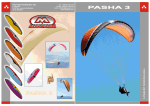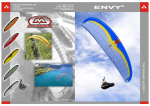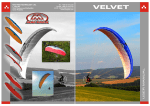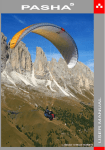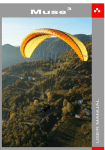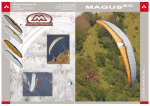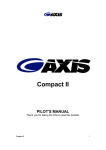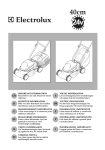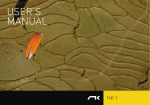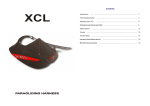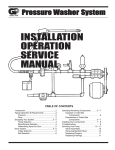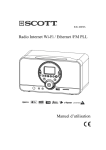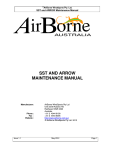Download user manual -
Transcript
EDEN 3 Contents General ..................................................................................................................... Introduction ............................................................................................................ Operating limits ...................................................................................................... Construction ........................................................................................................... Trim ........................................................................................................................ Safety equipment ................................................................................................... Speed System ....................................................................................................... 2 2 3 4 4 4 5 Flying operations ................................................................................................... Checklist ................................................................................................................ Take-off .................................................................................................................. Flight ...................................................................................................................... Steering ................................................................................................................. Approach and landing ............................................................................................ Flight with speed system ....................................................................................... Towed flight and motorized flight ........................................................................... 6 6 6 7 7 7 8 8 Extreme and critical flight manoeuvres ............................................................... Collapse of the canopy .......................................................................................... - Asymmetrical collapse ...................................................................................... - Symmetrical collapse ........................................................................................ - Frontal deflation ................................................................................................ Stalls ...................................................................................................................... - Parachutal stall steering lines ........................................................................... - B-line stall ......................................................................................................... - Spin (Negative spiral) ....................................................................................... - Full stall ............................................................................................................. Spiral drive ............................................................................................................. 8 9 9 10 10 11 11 11 12 12 13 Descent rates ......................................................................................................... 14 USER MANUAL Special Design Maintenance and repairs Material description ....................................................................................... 14 ............................................................................................... 15 Ground plan ............................................................................................................. 16 Line plan AC ............................................................................................................. 17 Line plan BD ............................................................................................................. 18 Manual for Paraglider checks ............................................................................... 19 Components of the check ...................................................................................... 19 Checks ..................................................................................................................... 21 Test flight certificate / Technicla data .................................................................. 22 GENERAL Introduction Warning and safety precautions We congratulate you on your purchase of a MAC-paraglider. The buyer of this product accepts full responsibility for all risks associated with paragliding inclusive of injury and death. Any inadequate use or misuse increases the risks considerably. The buyer should be aware of the need to complete a paragliding training course and should be in possession of a valid flying licence as required by the relevant country. Any changes made to this paraglider invalidate the certificate of airworthiness. Extensive development work and numerous tests make the EDEN 3 a high performance intermediate paraglider with maximum possible safety. The EDEN 3 is constructed for thermal and cross-country flying, and will enable pilots to get maximum enjoyment. Please read this manual carefully before you start, this way you will get the most out of your glider, and enjoy many “Eden flights” Paragliding is a sport, which demands, besides the optimum equipment, a high degree of attentiveness, good judgement, and theoretical knowledge. Paragliding can be a dangerous sport, which may lead to injury and death. Avoid flying in strong turbulence, strong winds and especially in thunderstorms and Foehn conditions. These could lead to uncontrollable flight conditions and result in a crash. If you have the slightest doubt about weather, wind or terrain, don’t take off. Before delivery, as well as during production, each paraglider goes through a strict visual inspection, and is test-flown by your dealer. Stamps on the placard, together with a completed test-flight certificate, confirm this. Check that the paraglider has been testflown before your first take-off. If it has not, consult your dealer. If, after carefully reading this handbook, you still have questions, telephone your dealer; or us we will be glad to help. The EDEN 3 must not be used: - outside the certified weight range - during rain or snow-fall - in high or gusty winds - in cloud and fog - by pilots without sufficient knowledge or experience The EDEN 3 is certified for solo flight. Operating limits The EDEN 3 has been developed for foot-launch, and for solo flights. The EDEN 3 has been tested by DHV test pilots to DHV 1-2 GH category. The GH stands for 95% of all sitting harnesses in use. It simply means that a harness with a chest-strap is needed. It also has been load and shock-tested and passed with a load corresponding to 12 G of the maximum weight in flight 130 kg. DHV requires 8G. Its flying test have shown that the glider remains stable and controllable over a wide range of normal and abnormal flight conditions. Nevertheless, turbulence and gusting winds can lead to a partial or complete collapse of the canopy. Therefore never fly in such conditions. MAC Para Technology ltd wish you many pleasant flights with your EDEN 3 2 3 Construction Speed system The EDEN 3 is a second rib diagonal-construction paraglider. Every second main rib is attached to the lines and other ribs are attached at A, B and C-points thanks to the diagonal segments. These segments do not lead to top surface of canopy but are attached at 80% of rib's height. This technique was already used on the EDEN 1 and is used by many other manufacturers in the industry. To fly faster than trim speed the EDEN 3 is equipped with a foot operated original speed system. When in use, it lowers the angle of attack. EDEN 3 is designed with a 5-riser system to further improve safety. EDEN 3 has a very wide speed range. The highly effective speed system of the EDEN 3 allows a 10 - 12 km/h gain in speed. Eden 3-22, -24 ( shorter risers for smaller pilots ) Riser Trimmposition Accelerated A 45,5 cm 28,5 cm B 45,5 cm 30,5 cm C 45,5 cm 38,0 cm D 45,5 cm 45,5 cm A 49,5 cm 32,0 cm B 49,5 cm 34,5 cm C 49,5 cm 42,0 cm D 49,5 cm 49,5 cm Eden 3-26, -28, -30, -33 Riser Trimmposition Accelerated Trim The glider is delivered with a standard set-up and its speed can reach 36 - 38 km/h depending on the weight of the pilot. The brake-lines should always be adjusted so that the first brake-lines just come under tension when the brake handles have been pulled 5 - 10 cm. A A1 B C A A1 B D The test results relate to this brake-line adjustment. In extreme situations other settings may lead to the glider reacting differently. To be able at all times to react quickly enough to possible problems; you should not let go of the brake handles during the flight (it may be possible to hold both handles in one hand). Alter the line length to bring the handles to a suitable height when using your harness. NOTE!! If in doubt about the brake-line adjustment, it is preferable to leave them too long, as any necessary shortening can easily be achieved by wrapping them round your hand. Safety equipment An optimal outfit should be a matter of course for every paraglider pilot. Always wear stout footwear, a helmet, and gloves. Clothing should be warm and allow sufficient freedom of movement. A rescue-system can be life-saving in case of an irremediable disturbance of the canopy, collapse in the air or material failure, and is therefore imperative. 4 5 C D FLYING OPERATIONS New glider check and before every flight check In additional to all the usual pre-flight checks, please pay particular attention to the items in the following checklist: Checklist 1. Inspection of canopy for tears or damage, especially the seams which join the ribs to the upper and lower surfaces, but also the area of the attachment tapes and brake-line connections. 2. Inspection of the attachment tapes for damage to the stitches. It is also important to check the attachment tapes and brake-lines for tangles. The line lengths must be checked after 50 hours flying time and whenever the flight behaviour of the glider changes. 3. Inspection of the risers and maillons for faultless condition. Special inspection of the maillons for traces of corrosion under the lines. 4. Inspection of the knotting of the steering handle to the brake-lines. The brake-lines must run freely. 5. Inspection of the harness. The harness must show no signs of wear or other damage. You must also check the harness after a hard landing. 6. Check whether the rescue-system is correctly installed and secured. 7. Inspection of the karabiner. Inspection of the attachment and securing of the karabiner. Take-off Find a suitable take-off spot, from which you can abort the take-off at any point. After checking the glider, following the checklist, lay it out with the cell-openings upwards so that the canopy forms the shape of a horseshoe. In a strong wind don't spread the canopy too far, so that there is less resistance when pulling up. Forward launch This is possible in almost all wind conditions except strong headwinds. It is essential to stand in line with the canopy, especially when the glider has longer lines. Before take-off, place yourself centrally at the gliders axis. Let the B C and D-risers fall into the crook of your arm and pull the canopy dynamically up by the A-risers. The stronger the headwind the less run-up you need to pull the canopy up. As soon as the glider is above you, stop pulling on the A-risers. Now do a visual check upwards, to see if the canopy is completely open. Otherwise, abort the take-off. Now accelerate continuously until you lift off. In a weak headwind it is easier to take-off if after reaching minimum flying speed you pull the brakes slightly. After the take-off, gently release the brakes again. WARNING!! Do not use the forward launch in very strong winds. Make sure you don't pull the risers too much towards yourself or downwards as this can result in a frontal collapse, or in an asymmetric take-off. Rear launch strong, take some of the pressure out of the canopy by taking in one or both of the brakelines (or the C-risers). Flight Always fly with sufficient clearance from the terrain. The EDEN 3 glides best with open brakes, descends best with lightly applied brakes. In turbulence fly with brakes lightly applied to avoid canopy collapse. If the canopy pendulums forward, this should be corrected by prompt braking. A pendulum movement of the canopy backwards is corrected by loosening the brakes in good time. Steering Turns can be initiated using the brakes in two different ways. Turns with brakes The pilot pulls the brake on the side to which he wishes to turn. To minimise sinking, the brake on the outside of the curve is lightly applied. Turns with brakes and weight shifting The pilot pulls the brake on the side to which he wishes to turn and shift his weight to the same side. Turns can also be flown with the harness alone, by shifting the weight to the inside of the curve. This weight shift has a greater effect, the more loosely the chest-strap is fastened. An optimal steering technique is achieved by a combination of braking and weight shifts. It is pilot's skill to use both of these techniques specially in thermals. A further possibility for steering is best limited to emergencies (if the brake-lines break, for example). This entails gently pulling the front (watch out for collapse of the canopy) or on D-riser (beware asymmetrical stall). We recommend that you do not use this form of steering in normal flight. Approach and landing To avoid stressful situations in the approach to landing, it is important to initiate the process at an adequate altitude. This leaves you enough time to observe and appropriately deal with wind direction and any other aircraft in your vicinity. The final approach should generally be made into the wind and with fully released brakes, in order to maintain maximum energy in the glider. If the air is turbulent, it is better to land lightly braked to minimise the possibility of the canopy collapsing. In order to land on your feet, rather than lying on your back, you will need to lean forward in the harness not lower than 5 m above the ground. At an adequate height (about 1-2 m above the ground), pull both brakes fully down until the glider is sufficiently slowed. To be used in moderate to strong headwinds. Please note that in a strong headwind you may need a helper, as you could easily lose control of the canopy. If the headwind is too In a light headwind pulling the brakes only lightly is enough to give a soft landing. In a calm, or even tailwind, you must pull the brakes as abruptly as possible. This dynamically increases the angle of attack and gives you the maximum braking effect. 6 7 Flight with speed system Collapse of the canopy To make faster flight possible, the EDEN 3 is equipped with a special speed system. Remember this is a glider with unspectacular reactions to disturbances in the air. Whenever in doubt, let up the brakes and let the glider fly. The glider has a high internal pressure, resistance to tucking and very high degree of passive safety. It is recommended that at this stage you already start to practising an active flying style. The key to active piloting is keeping the glider above your head at all times. We recommend in principle that you hold the brake handle in your hand whenever possible, or fly with your hands through the brake handles, to allow you to react immediately to any possible disturbances. To accelerate the paraglider we recommend the following steps: a) extend the speed bar b) use the speed bar to control speed Never activate the speed system in turbulence, at low altitude, or when approaching a landing (the lower angle of attack results in less stability despite the higher speed). WARNING!! If you fly with your hands through the brake handles, you may lose valuable time for activating the rescue system. Towed and motorized flight The EDEN 3 is suitable for towed flight, and is excellent glider for flying with a paramotor! Note!! However, motorized flying has been made with great success due to its very easy take-off characteristics, stability and good handling, always use certified combinations of engine - harness - glider. If in doubt check with your federation. EDEN 3 has no tendencies towards deep stall/parachuting. Therefore we allow towlaunched flights with a similar techniques to that described above. There is sufficient margin to counter-steer the glider in a normal towing situation. Make sure you use proper equipment, experienced personnel and all relevant safety precautions for towing. WARNING!! Please always ensure that the brake lines are adjusted to the lengths recommended here. Setting them shorter could lead to a tendency to stall during towed flight. Apart from this, there are no special procedures. WARNING!! The EDEN 3 is not suitable for jumps from aircraft. EXTREME AND CRITICAL FLIGHT MANOEUVRES This section describes flying conditions which can be deliberately induced, or which can develop unintentionally due to turbulence or pilot error. Any pilot who flies through turbulence is sure to be faced with these special flight conditions at some point. So take a good look at these flight manoeuvres or prepare for them by SIV (safety training over water). Mastering these flying conditions significantly improves your active flight safety. Sufficient height, as well as the carrying of a reserve parachute, is imperative. Asymmetrical collapse This form of collapse occurs most frequently, caused by turbulence. Initiation Pull the outermost A-riser slowly down, until the edge of the canopy folds in. The canopy collapses furthest if you pull both A-risers violently down. This causes up to 70 % of the leading edge to close up, and results in the canopy going into a spiral towards the collapsed side. If the harness is too loosely adjusted, in a more extreme collapse you will fall in the direction of the folded-in side, thus unintentionally magnifying the canopy's tendency to turn. Recovery Basically the EDEN 3 will re-open by itself from closures of up to 70% by turning of 90°. The time this takes, and the associated loss of height, can however be noticeably reduced by appropriate action by the pilot. Apply opposite brakes on the un-collapsed side, the outside of the curve, to stop the turning movement of the canopy. If you react immediately, 30% brake on the open side should suffice to hold the canopy on a straight course. WARNING!! Especially in turbulence, you must first stop the canopy turning, before you pump out the collapsed side. When the canopy is stable again, open it by pulling the brake lines on the closed side. If it is tangled, pumping the brake line should help. WARNING!! All the critical flight conditions described here require thorough knowledge; otherwise carrying them out may be very dangerous. Sufficient height above the ground is imperative. Bear in mind that all disturbances of the canopy can increase the sink rate by 2 - 10 m/sec, depending on the degree of disturbance. Carrying out these manoeuvres wrongly may lead to a crash. WARNING!! Take care to avoid applying too much brake when pumping out the deflation, as this may disrupt the airflow over the canopy and lead to a stall. 8 9 WARNING!! In the case of a cravat which pumping of the brakes fails to release - apply 50% -70% brake on the open side of the canopy to stop rotation. Then pull the caught line carefully to release it then pump out the affected side. Take care to avoid applying too much brake when pumping out the deflation, as this may disrupt the airflow over the canopy and lead to a stall. Stalls Turbulence or rapid braking can lead to a pendulum effect, and thus to changes in the angle of attack. In extreme cases this can make the airflow break away from the upper surface of the canopy even without the brakes being activated. WARNING!! All canopies need some time after a stall (in extreme cases a couple of seconds) before the airflow builds up again. You should therefore carry out all manoeuvres involving stalls at an adequate height, as it will take a certain amount of time before the glider flies with its normal sink rate. Symmetrical collapse - "Big-Ears" Initiation Whilst maintaining contact with the brakes, grip the outermost A-risers. Work your hands as high as possible on these A-risers, until you have enough to be able to pull on them without pulling second A-risers as well. Pull outer A-risers down simultaneously. The further you pull the A-risers, the greater the area of canopy that will collapse (and the greater will be the sink rate). Recovery As soon as you release outer A-risers, the EDEN 3 opens independently. You can speed up its opening by light braking. If in extreme cases the lines get tangled, pumping (pulling repeatedly) the brake lines should help. Parachutal stall with steering lines Initiation Pull the brakes slowly down until you have no more forward speed. The canopy now loses internal pressure and the lower surface pushes further and further up between the suspension points. The loss of internal pressure is greater the longer the glider is held in this situation. During the parachutal stall the canopy always remains open. You will probably have to feel for the right brake position at first. If you apply too much brake, the canopy falls away backwards and the glider finds itself on the brink of a full stall. Loosen the brake lines immediately, until the canopy is once more above you. If you hesitate too long, the canopy will surge forwards. Frontal deflation Recovery If you feel strong turbulence coming, first step off the speedbar. Sometimes you may have to pull both brakes to avoid a deflation. Initiation Hold the brake handles in your hands and grip all A-risers at the level of the maillons. Now pull down far enough to make the whole leading edge fall in (the further you pull, the more area folds in). As soon as you release both brakes, symmetrically, the glider will independently recover from the parachutal stall. WARNING!! In a parachutal stall, asymmetrical application of the brakes can lead to a spin. If you must land from a parachutal stall, on no account apply the brakes very close to the ground, as a reduction in area increases the descent rate. B-line stall Recovery As soon as you release the A-risers, the EDEN 3 opens by itself and the glider will recover with a small surge. You can speed up this process by light braking. If the A-risers are held too long, the canopy could fold in the middle with the wing tips going forward. NOTE!! EDEN 3 usually opens from frontal tuck by itself. If counter braking, be careful do not brake too much. You could cause glider to begin a full stall with following surge forwards. 10 Initiation Put your hands through the brake handles and grip the B-risers at the height of the maillons. Now pull the B-risers slowly down, until the canopy folds (parallel to its long axis). The glider will now stabilise itself and sink rapidly, with virtually no forward speed. Keep hold of the B-risers throughout the manoeuvre. 11 Recovery Recovery Release the riser at first rapidly but then gently. After the B-line stall on no account just let go of the B-risers, as this can cause overloading. As soon as the risers have been released, the EDEN 3 will usually fly normally of its own accord. Otherwise you have two possibilities: Let go fluently both brakes simultaneously until 90% of leading edge reopen, then release brakes rapidly. The glider ends the full stall on its own without surging forward. 1. Pull the A-risers, until the canopy regains forward speed. WARNING! Don't pull too far, or a frontal tuck will develop. 2. Pull the brake lines until the canopy wants to fall backwards, and then instantly open both brakes symmetrically. As a result the canopy will shoot forwards, thus regaining forward speed. So begin with option 1, and only rely on option 2 when you have enough experience with the manoeuvre. Spin (negative spirals) If you find yourself in an unintentional spin and you are high enough, you should: 1. Release the brakes immediately. The glider will stop rotating, if it does not apply sufficient outside brake to stop rotation. 2. Gently apply the brakes to avoid a central collapse of the canopy and the possibility of a cravat (one of the tips becoming entangled in the lines). NOTE!! In the case of a cravat which pumping of the brakes fails to release - apply 50% 70% brake on the open side of the canopy to stop rotation. Then pull the caught line carefully to release it then pump out the affected side. WARNING!! If you are LOW and are in an unintentional spin, or if the canopy is caught in a cravat USE YOUR RESERVE. Full stall This is included only to expand your knowledge of how the canopies performance. Not recommended as a descent technique. WARNING!! If the brakes are released rapidly and asymmetrically, the glider may turn through almost 90 degrees and suffer an extensive asymmetric collapse. Spiral dive EDEN 3 has very effective spiral dive. This allows rapid descent without stalling. Initiation Weight-shift and pull the brake on one side gradually. Let the glider accelerate for two turns and enjoy the growing speed and high G-force. You can achieve sink rates up to 20 m/s. Once you have entered the spiral you can control your descent rate and bank angle with weight shift and brakes. We recommend lightly applying the outer brake to avoid asymmetrical collapse on outer side of canopy. Recovery Weight-shift to a normal flying position and stop application of both brakes. The glider stops spiral diving by itself in 360 degrees. If you apply inner brake and decelerate the glider for two or three turns, big pendulum effects can be avoided. WARNING!! Some gliders have a tendency to stay in the spiral when the sinkrate exceeds around 15 m/s, depending on weight-shifting, wing loading and G-force. In fact most gliders need a counter-input to end a turn. With weight-shifting to the normal sitting position EDEN 3 will however come out of the spiral without pilot input. Practise spiralling with caution and lesser sinkrates to get a feel for the gliders behaviour. A pilot who is dehydrated or not accustomed to spiralling can lose consciousness in a steep spiral dive! Initiation Take wraps until the glider is lightly braked (when the hands are right up). Now gently pull both brake lines, until the canopy falls away behind - at this point, dynamically pull the brakes fully down. Press your hands against your body. The glider is now over you, with the wing tips flapping. As a result you sink rapidly with no forward movement. 12 13 DESCENT RATES Fly as far as possible from steep rises, to give yourself space to lose height. MATERIAL DESCRIPTION FABRIC OF CANOPY NCV - PORCHER MARINE Wassoilles Rue du Ruisseau B.P. 710 38290 ST. QUENTIN FALLAVIER, FRANCE Symetrical collapse - "big ears" Sink rate approximately 2-4 m/sec Speed system and "big ears" Sink rate approximately 4-6 m/sec Spiral dive This allows rapid descent without stalling. Sink rate, depending on pilot, 5-15 m/sec B-line stall Sink rate approximately 5-10 m/sec Important! - End the stall with sufficient time for the airflow to re-establish itself. In principle, always fly in such a way that you do not need to lose height in a hurry. MAINTENANCE AND REPAIR The EDEN 3 is produced from the best materials (see Material Description). The glider must be checked as a minimum, every year or after 100 flying hours. Do not step on the lines. Although the lines were tested with „DHV-bend test“ they can be damaged if stepped on whilst on a hard surface, or if they come into contact with sharp objects. If this happends contact your dealer for replacement lines. The lines must be checked after every 50 hours flying time and whenever the flight behaviour changes. Consult your dealer or MAC ltd. Tears in the canopy must be professionally sewn. Adhesive patches are only adequate for very minor damage. The glider must always be kept cool and dry. If possible it should be stored lightly folded in a well-ventilated place. Protect the glider from dampness and sunlight. Exposure to UV degrades the fabric. A damp or wet canopy must be air-dried in a shady place. Do not expose the glider to temperatures of greater than 50 degrees C, as this can cause softening and shrinking of the attachment tapes. Clean the canopy only with warm water or a dilute soap solution. Do not use solvents. Extrados - SKYTEX S9017 E77A,E38A - 100% nylon 6.6 , 33 Dtex, 40 g/m2 Intrados - SKYTEX S9017 E38A - 100% nylon 6.6 , 33 Dtex, 36 g/m2 Main ribs - SKYTEX S 9017 E29A - 100% nylon 6.6 , 33 Dtex, 40 g/m2 Ribs - SKYTEX S 09017 E38A - 100% nylon 6.6 , 33 Dtex, 40 g/m2 Reinforcement main ribs - Grille Polyester 200 g/m2 Reinforcement ribs - W382 Polyester 180 g/m2 LINES EDELMAN+RIDDER+CO. Achener Weg 66, D-88316 ISNY IM ALLGEAU, GERMANY Upper lines - Aramid/Polyester A-6843-080, Breaking Load 80 kg Middle lines A,B - Aramid/Polyester A-6843-160, Breaking Load 160 kg Middle lines C,D - Aramid/Polyester A-6843-120, Breaking Load 120 kg Brake lines - Dynema/Polyester A-7850-100, Breaking Load 100 kg Main lines C1,C2,C3,D1,D2,D3 - Aramid/Polyester A-6843-160, Breaking Load 160 kg Main lines A1,B1 - Aramid/Polyester A-6843-200, Breaking Load 200 kg Main lines A2,A3,B2,B3 - Aramid/Polyester A-6843-240, Breaking Load 240 kg Wing tip line - Aramid/Polyester A-6843-080, Breaking Load 80 kg Main brake line - Dynema/Polyester A-7850-240, Breaking Load 240 kg BRIDLE (ATTACHMENT LINES) STAP a.s. 407 80 VILEMOV, CZECH REPUBLIC STAP-POLYESTERBRIDLE 13 mm, Breaking Load 95 kg RISER MOUKA TISNOV ltd Koráb 133, 66601 Tišnov, Czech Republic Polyester 367 040 025 912 25x1,5 mm Breaking Load 800 kg THREAD EDEN 3 is delivered with a stuff-sack, T-shirt, MAC rucksack, speedbar and user manual. AMANN SPONIT ltd Dobronická 635, 148 25 PRAHA 4, CZECH REPUBLIC Happy landings Lines - SYNTON 60 Breaking Load 3,5 kg, Mean lines - SERABOND 60 Br. Load 7 kg Canopy - SYNTON 40 Breaking Load 6 kg, Riser - SYNTON 30 Breaking Load 12 kg Peter Recek - Constructeur MAC PARA TECHNOLOGY ELAIR SERVIS MAILLONS NIRO TRIANGLE 200 - Max. Load 200 kg 14 15 16 C25 A25 C23 mC3 A23 mA3 17 br17 C21 A21 br16 br15 C19 A19 br14 C17 s2C A17 s2A mC2 mA2 26 26 25 25 br13 C15 A15 26 26 24 br22 s1C s1A 25 25 24 23 23 23 br12 C13 A13 24 24 23 22 22 21 20 20 C11 21 21 mBR br21 br11 A11 22 22 21 19 br10 20 20 19 19 19 18 18 17 br20 18 18 17 16 15 br8 br19 br9 C9 16 16 15 14 14 A7 15 15 br7 C7 mA1 mC1 A9 17 17 16 14 14 12 12 12 12 br18 br5 C5 A5 13 13 br6 13 13 11 11 10 10 br4 9 9 br3 C3 10 A3 11 11 10 9 9 br2 8 8 8 8 7 7 6 br1 7 7 6 6 6 5 5 4 stD stC stB stA 5 5 4 4 4 3 3 2 2 st0 3 3 2 2 1 1 1 1 GROUND PLAN LINE PLAN AC LINE PLAN BD MANUAL FOR PARAGLIDER CHECKS All paragliders used in flight must be checked at least every 24 months. For paragliders used by paragliding schools the period is 12 months. br1 stD stC stB stA st0 Check-intervals br3 A valid flying license and training course by National association are the basis for permission to carry out paraglider checks br18 br6 B5 D5 br5 br4 D3 B3 br2 Personnel authorised to carry out checks Identification of glider br9 br19 br8 D7 Components of the check br20 D9 mD1 B9 mB1 B7 br7 An identity sticker with details of certification and serial number is attached to the glider. br21 br11 br22 br12 E13 E15 br13 Dt E17 E23 E25 Dt br17 E21 br16 br15 Dt Dt D23 D25 mD3 Dt D21 B21 B25 B23 mB3 The porosity should be checked with a porosity meter (JDC). Compare the resultant data with the producer's manual. Porosity measures should be taken on at least three points of both the top and bottom surface. The first point should be placed 20-30 cm from leading edge in the middle of canopy. Second and third points are placed left and right from first measure point at 25% of the span. One additional measurement should be made on the top surface of the wing tip. The identified time should be higher than 30 second (JDC). In the event of the result being less than 30 seconds, the result of the check is a fail. Overall strength check E19 D19 br14 D17 s2D B19 s2B B17 Dt mB2 mD2 B15 D15 s1B s1D D13 B13 Dt D11 mBR E11 B11 Dt br10 Porosity The check of canopy strength should be made with a Bettsometer (B.M.A.A approved Patent No. GB 2270768 Clive Betts Sales). On the top and bottom surfaces make small holes with a needle at the Aline attachment points. The exact verification should be made in accordance with the Bettsometer user manual. Line strength check Line strengths should be as specified in accordance with the DHV requirements. One main line should be taken from each array and have its strength checked with a tensionmeter. Required strengths should be higher than: - A + B main lines x measured value > 8 x maximum take-off weight and higher then 800 kg for the A + B arrays. - C + D mean lines x measured value > 6 x maximum take-off weight and higher then 600 kg for the A + B arrays. Replacements for damaged lines must be with new original lines. Line lengths are taken from the lines data page. 18 19 CHECKS Line length measurement Lines should be separated and each line measured under a tension of 5 kg. Measurement is made from the line karabiner to the canopy according to the DHV method. Rib numbering begins in the middle of canopy and leads to the wing tip. Measured full lengths should be documented in the inspection record and are compared with the DHV type protocol. Lengths should not differ by more than 20 mm. The opposite sides should be checked for symmetry. Name Company Date Canopy line-attachment points check Attachment points should be checked for damage and stretching. Defects, loops and flares should be repaired. Canopy fabric check Ribs, diagonal ribs, top and bottom surface should be checked. Any damage to sewing or tears to the fabric, which could influence flying characteristics must be repaired. Lines All lines should be checked for tears, breaks any damage to the sheath or signs of wear. Special attention should be paid to the sewing of the line loops. Damaged lines must be replaced. The results should be documented in the inspection record. Connector check All line carabineers, trimmers (if used), speed systems and pulleys should be inspected for visible damage. Open or improperly secured connectors should be secured in accordance with the producers recommendations. Risers Both risers should be checked for tears, signs of wear or any damage and measured with a pull of 5 daN strength. Measured data should be documented in the inspection record. The difference must not be higher then 5 mm when compared to specified lengths. Final check The glider sticker and check sticker must be inspected for readability and correctness. The check must be documented with date, signature and stamp on the canopy and in the user manual. 20 21 Signature & Stamp MAC PARA TECHNOLOGY LTD. 1. máje 823 756 61 Rožnov pod Radhoštìm Czech Republic TEST FLIGHT CERTIFICATE Paraglider type: Tel.: +420 571 842 235 Tel./fax: +420 571 842 332 e-mail: [email protected] www.macpara.com EDEN 3 - Serial number: Test flown on: producent by MAC PARA TECHNOLOGY Confirmation by dealer: TECHNICAL DATA size Zoom flat [%] Area flat [m2] Area projected [m2] Span flat [m] Aspect ratio flat Root cord [m] Cells Weight [kg] Weight range [kg] Min.speed [km/h] Max.speed [km/h] Top speed (accelerator) [km/h] Glide ratio Min. Sink rate [m/s] Eden 3 22 92 22,24 19,72 10,62 5,26 2,63 50 5,5 62-80 23-25 36-38 46-48 8,2 1,15 Eden 3 24 92 23,66 21,14 11,16 5,26 2,63 52 5,8 70-90 23-25 36-38 48-50 8,3 1,15 Eden 3 26 Eden 3 28 96,5 26,03 23,26 11,7 5,26 2,76 52 6,0 77-100 23-25 36-38 48-50 8,3 1,15 100 27,96 24,99 12,13 5,26 2,86 52 6,2 85-110 23-25 36-38 48-50 8,3 1,15 Eden 3 30 104 30,24 27,02 12,61 5,26 2,98 52 6,5 100-130 23-25 36-38 48-50 8,3 1,15 Eden 3 33 109 33,21 29,68 13,22 5,26 3,12 52 6,8 115-145 23-25 36-38 48-50 8,3 1,15 Special Design DHV 1-2












